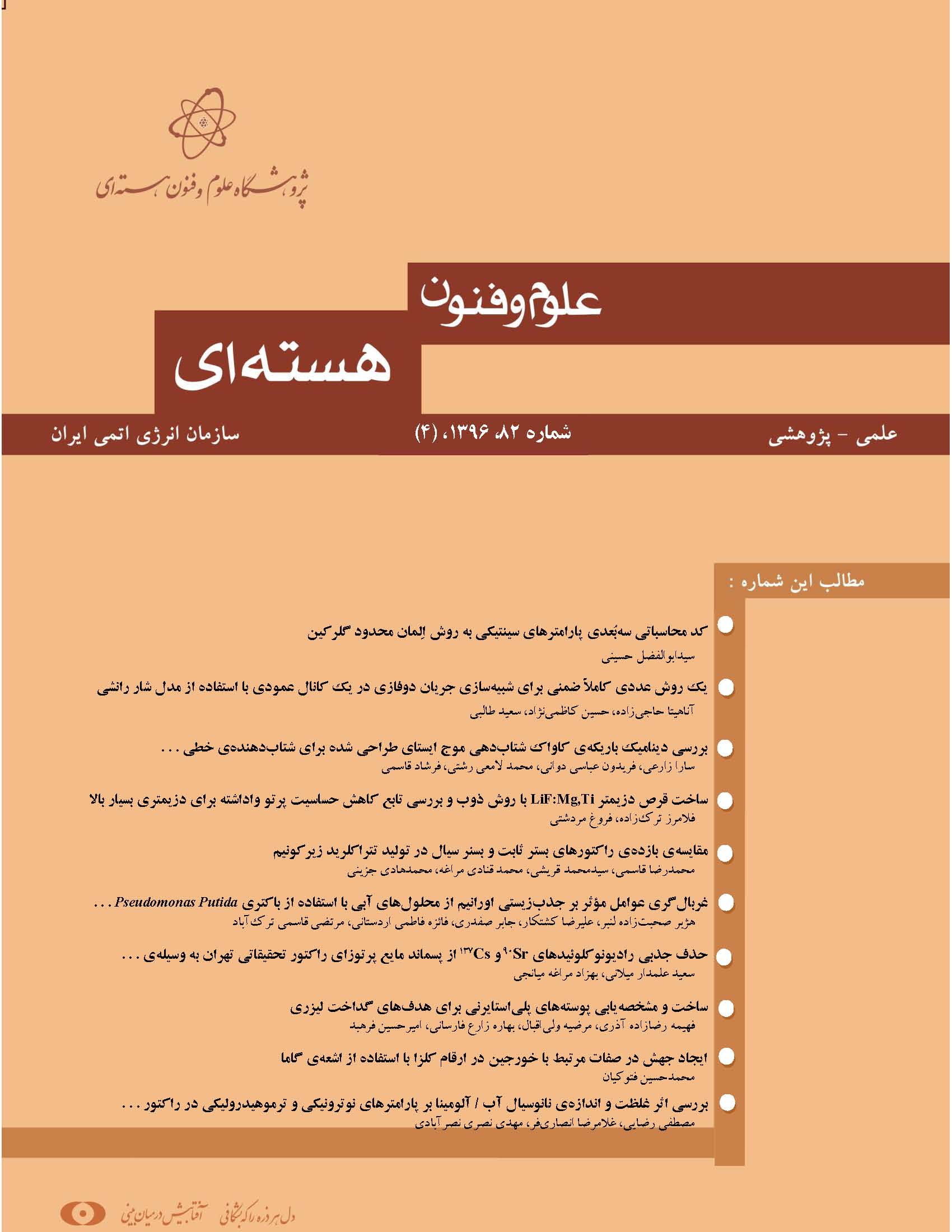[1] L. Zou, H. Zhao, H. Zhang, Applications of high-resolution spatial discretization scheme and Jacobian-free Newton–Krylov method in two-phase flow problems, Ann. Nucl. Energy. 83 (2015( 101–107.
[2] D.A. Knoll, D.E. Keyes, Jacobian-free Newton–Krylov methods: a survey of approaches and applications, J. Computational. Phys. 193 (2004) 357–397.
[3] M.A. Pope, V.A. Mousseau, Accuracy and efficiency of a coupled neutronics and thermal hydraulics model, Nucl. Engin. Tech. 41(7) (2009) 885-892.
[4] C. Frepoli, H. Mahaffy, J. Ohkawa, Notes on the implementation of a fully implicit numerical scheme for a two-phase three-field flow model,Nucl. Eng. Des. 225 (2003) 191-217.
[5] L. Zou, H. Zhao, H. Zhang, On the analytical solutions and numerical verifications of the two-phase water faucet problem, In: 16th International Topical Meeting on Nuclear Reactor Thermal-hydraulics, August 30, September 4, Chicago, Illinois, USA, 2015.
[6] L. Zou, H. Zhao, H. Zhang, Numerical implementation, verification and validation of two-phase flow four-equation drift flux model with Jacobian-free Newton–Krylov method,
Ann. Nucl. Energy. 87(2) (2016) 707–719.
[7] R.A. Abu Saleem, T. Kozlowski, Development of accurate and stable two phase two-fluid model solver. In: Proceedings of ICAPP, Charlotte, USA, April 6–9 (2014).
[8] W.
Xu, TH.F
Coleman, Solving nonlinear equations with the Newton–Krylov method based on automatic differentiation,
Optim. Method. Softw. 29(1) (2014) 88-101.
[9] N. Zuber, J.A. Findlay, Average volumetric concentration in two-phase flow systems, J. Heat. Transf. 87 (1965) 453-468.
[10] RETRAN-3D– A Program for Transient Thermal-Hydraulic Analysis of Complex Fluid Flow Systems: Volume 1: Theory and Numerics (Revision 3) NP-7450- V1R3.
[11] S. Gao, D.C. Leslie, G.F. Hewitt, Improvements to the modelling of two-phase flow and heat transfer in a transient nuclear reactor analysis code. Appl. Therm. Eng. 28 (2008) 915–922.
[12] S. Talebi, H. Kazeminejad, H. Davilua, A numerical technique for analysis of transient two- phase flow in a vertical tube using the drift flux model,Nucl Eng. Des. 242 (2012) 316-322.
[13] Y.G. Lee, G.Ch. Park, TAPINS: A thermal-hydraulic system code for transient analysis of a fully-passive integral PWR, Nucl. Eng. Technol. 45(4) (2013) 439-458.
[14] H.J. Khan, H. Yi, Subchannel analysis in BWR fuel bundles. Ann. Nucl. Energy. 12 (1985) 559–572.
[15] T.M. Hibiki, M. Ishii, One-dimensional drift flux model and constitutive equations for relative motion between phases in various two-phase flow regimes, Int. J. Heat. Mass. Tran. 46 (2003) 4935–4948.
[16] M. Ishii, T. Hibiki, Thermo-fluid Dynamics of Two-phase Flow, Springer (2006).
[17] W. Wagner, A. Pruss, The IAPWS formulation 1995 for the thermodynamic properties of ordinary water for general and scientic use, J. Phys. Chem. Ref. Data. 31 (2002) 387-535.
[18] C.W. Hirt, T.A. Oliphant, W.C. Rivard, N.C. Romero, M.D. Torry, SOLA-LOOP: A Nonequillibrium, Drift-Flux Code for Two-Flow in Networks, LA-7659 (1979).
[19] L. Sun, K. Mishima, Evaluation analysis of prediction methods for two-phase flow pressure drop in mini-channels, Int. J. Multiphas. Floe. 35 (2009) 47–54.
[20] Y. Xu, X. Su, Z. Zhou, W. Chen, Evaluation of frictional pressure drop correlations for two-phase flow in pipes,Nucl. Eng. Des. 253 (2010) 86–97.
[21] R.T. Lahey, A Mechanistic Subcooled Boiling Model. Proceeding in 6th International Heat Transfer Conference, 1 (1978) Toronto, Canada, 293-297.
[22] J.G.M. Andersen, R. Harrington, B. Hizoum, COBRA Subchannel Code: Model Description Report, NEDE-32199P, Revision 1 (2007).
[23] S. Levy, Forced convection sub-cooled boiling-prediction of vapor volumetric fraction, Int. J. Heat. Mass. Tran. 19 (1967) 199–113.
[24] B. Chexal, Chexal-Lellouche, void fraction correlation for generalized applications, NSAC-139 (1991).
[25] H.K. Versteeg, W. Malalasekera, An Introduction to computational fluid dynamics: The finite volume, New York: Longman Scientific and Technical (1996).
[26] S.V. Patankar, Numerical heat transfer and fluid flow, Hemisphere Publishing Corporation, New York (1980) 58-70.
[27] G.G. Bartolomei, V.M. Chanturiya, Experimental study of true void fraction when boiling sub-cooled water in vertical tubes, Therm. Eng.+ 14 (1967) 123–128.
[28] G.G. Bartolomei, V.G. Brantov, Y.S. Molochnikov, Y.V. Kharitonov, V.A. Solodkii, G.N. Batashova, V.N. Mikjailov, An experimental investigation of true volumetric vapor content with sub-cooled boiling in tubes, Therm. Eng.+ 29(3) (1982) 132–135.
[29] RELAP5, RELAP5/MOD3 Code manual, NUREG/CR-5535, Sciencetech, Inc., Idaho Falls (1999).
[30] A.S. Devkin, A.S. Podosenov, RELAP5/MOD3 subcooled boiling model assessment, NUREG/IA-0025, U.S. NRC, Washington DC, (1998).
[31] S. Hari, Y.A. Hassan, Refinement of the RELAP5/MOD3.2 subcooled boiling model for low-pressure conditions, Proceding 8th International Conference in Nuclear Engineering, Baltimore, USA (2000).
[32] A.L. Degha, A. Chaker, Numerical study of subcooled boiling in vertical tubes using relap5/mod3.2, J. Electron Devices 7 (2010) 240-245.

